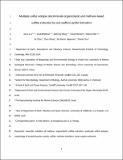Multiple sulfur isotopes discriminate organoclastic and methane-based sulfate reduction by sub-seafloor pyrite formation
Author(s)
Liu, Jiarui; Pellerin, André; Wang, Jiasheng; Rickard, David; Antler, Gilad; Zhao, Jie; Wang, Zhou; Jørgensen, Bo Barker; Ono, Shuhei; ... Show more Show less
DownloadLiu et al. 2021_GCA_multiple sulfur isotopes_final submitted.pdf (2.180Mb)
Publisher with Creative Commons License
Publisher with Creative Commons License
Creative Commons Attribution
Terms of use
Metadata
Show full item recordAbstract
The marine sulfate inventory represents the largest standing pool of electron acceptors, which, via microbial sulfate reduction, is responsible for roughly half of the organic matter mineralization globally in marine sediments. In addition to the oxidation of buried organic matter, sulfate reduction can be coupled to the oxidation of methane migrating upward. Multiple sulfur isotope ratios were measured for porewater sulfate, sulfide, elemental sulfur and pyrite from core samples collected from continental shelf (19–96 m water depth) in the Baltic Sea and slope (1098 m water depth) in the Andaman Sea, in order to test if their isotope systematics can be used to trace the two different sulfate reduction processes. For shallow shelf sediments (<43 cm below seafloor), both δ34S and Δ33S values of porewater sulfate increased with increasing depth as a result of organoclastic sulfate reduction (OSR). However, the Δ33S values of both porewater sulfate and sulfide decreased as the δ34S values increased downcore at 43–73 cm depth where sulfate reduction was coupled to anaerobic oxidation of methane (AOM). Pyrite in shelf sediments yielded positive Δ33S values, reflecting Δ33S of porewater sulfide produced by OSR. In contrast, pyrite in slope sediments yielded negative Δ33S values as low as −0.15‰, as a result of mixing of sulfides derived from OSR and AOM. This is consistent with the slowly migrating sulfate–methane transition (SMT) in slope sediments inferred from sulfur and iron speciation, carbon isotope ratios of carbonates, and magnetic susceptibility data. A stable SMT, focusing AOM at roughly the same depth over the past few millennia, further provides favorable conditions for prolonged pyrite formation with the development of cubic crystals, while the sulfur isotope difference between bulk pyrite and macroscopic pyrite reflects the significance of OSR throughout the sediment column. We conclude that minor sulfur isotopes provide a unique proxy that can be applied to differentiate OSR and AOM and the origin of pyrite in diverse sediments and sedimentary rocks. This contribution highlights strong local diagenetic controls on pyrite formation and its multiple sulfur isotopic composition in various marine settings.
Date issued
2022-01Department
Massachusetts Institute of Technology. Department of Earth, Atmospheric, and Planetary SciencesJournal
Geochimica et Cosmochimica Acta
Publisher
Elsevier BV
Citation
Liu, Jiarui, Pellerin, André, Wang, Jiasheng, Rickard, David, Antler, Gilad et al. 2022. "Multiple sulfur isotopes discriminate organoclastic and methane-based sulfate reduction by sub-seafloor pyrite formation." Geochimica et Cosmochimica Acta, 316.
Version: Author's final manuscript
ISSN
0016-7037